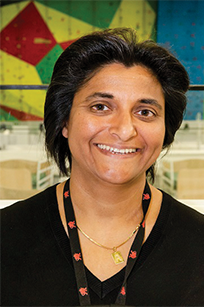Feature / Virtual reality
Often ideas that have been circulating for a while finally suit the needs of the times. Virtual wards are one example. The notion of caring for and monitoring patients out of hospital, potentially supported by the rapidly expanding mobile or wearable electronic medical devices industry, has been around a while. But it began to be adopted more widely due to the need to get appropriate patients out of hospital or keep them out of hospital during Covid. And now, as the NHS seeks to free up hospital beds to make post-Covid recovery a reality, virtual wards are being expanded further.
The NHS at home programme aims to support the national expansion of virtual wards, based on evidence that 16% of admissions could be supported through a virtual ward. The ambition is for integrated care systems to achieve 21 virtual ward ‘beds’ per 100,000 population by October 2022, rising to 40-50 beds by December 2023. In England that’s up to 25,000 virtual beds by the end of next year.
Virtual wards already exist, but the phrase has become a catch-all term for many types of service delivered at home. It can include integrated care in the community, case management delivered by district nurses, remote monitoring of one or two symptoms – a model that has sprung from the Covid pandemic – and post-discharge care.
Experts believe NHS clinicians and managers must ensure virtual wards are not seen as a separate service, but part of existing pathways. Microsoft chief clinical information officer Umang Patel says virtual wards need to have the same structure as bricks and mortar wards and common characteristics including:
- An easy-to-follow admission process to admit patients remotely
- A call-bell system – ensuring patients can call for help via a video conferencing and messaging app
- Regular observations – remote monitoring allows clinicians to keep an eye on each patient’s vital statistics
- Tests conducted by patients – which can be uploaded remotely under guidance from clinicians where required
- Instructions and prompts to patients on which medicines to take and when – patients should be able to confirm via the system that medicines have been taken
- Ward rounds via video conferencing
- Board rounds to allow a virtual ward team to review their patients using a remote whiteboard and productivity tools
- A streamlined escalation process to move patients to a physical hospital if their condition deteriorates
- Engaging the patient’s support network by extending communication to friends and family and formal carer
- A discharge process for patients to leave their virtual ward.
There is an assumption that virtual care equals cheaper care, but those who have set up the systems insist that this is not necessarily the case. A wide range of professional staff must be engaged to ensure patients are adequately supported to get the best possible outcomes.
On a more macro level, former NHS England director of strategy Robert Harris has questioned the economics of virtual wards. The 2022/23 planning guidance set out funding of £200m in 2022/23 and £250m the following year. Per bed, this means funding of between £7,100 and £9,000 in 2022/23. Assuming a 90% bed occupancy rate, this is about £22 per bed per day, he says, less than 10% of the normal inpatient bed cost.
If staffing accounts for around 80% of bed costs – whether in hospital or a virtual bed – the available funding is the equivalent of a few minutes of clinical time per day, he argues. But this does not include the cost of medication administration, software and monitoring equipment. It is difficult to see how this adds up without more funding, he insists.
An Institute of Health and Social Care Management roundtable on virtual wards earlier this year heard that as digital devices develop, there will be greater opportunities to introduce technology – in the use of wearables, for example. But staff will be needed to monitor, analyse and respond to the data produced.
Workforce impact
Potentially the biggest cost is workforce. But Alison Leary, chair of healthcare and workforce modelling at London South Bank University, says NHS England has launched virtual wards without first carrying out a workforce impact assessment.
‘There is a perception that if something works well in a pilot you don’t evaluate to find out why it worked well in that place,’ she says.
Workforce is critical to success, but she adds: ‘I have never seen a workforce impact assessment in the NHS, so you end up with copies of the original that probably don’t function as well. And instead of being resourced adequately, the community services have to find staff from the community workforce.’
Yet, virtual wards are having an impact on workforce. ‘When we started to do modelling on virtual wards, we found that district nurses are working on a lot of new services, not just virtual wards. A lot of these use technology, and this is increasing their workload. You can’t just provide the technology – [the results] need interpretation,’ says Professor Leary.
‘Virtual wards are not a bad idea; in some places, it works really well. But you must understand why it works well and recreate it properly. There isn’t the capacity in the community to keep absorbing ideas. Community teams are having to do virtual wards and other things as well as their normal caseload. It’s papering over the cracks. We don’t have enough acute beds. We have beds in the community, but we need to staff them properly.’
NHS England guidance says virtual wards should be delivered by a multidisciplinary team (MDT), led by a consultant practitioner or suitably trained GP. Its guidance includes six illustrations of staffing models, and staff numbers vary depending on the amount of face-to-face care needed. For example, one 50-bed service operating 24/7 has 54.7 whole-time equivalents (WTEs). Led by community matrons, staffing is provided by a mix of registered nurses and healthcare assistants, with specialist support from consultant (1.7 WTEs) and pharmacists (three WTEs).
A different virtual ward for patients with respiratory and cardiac issues – providing a mostly remote monitoring service, eight hours a day – has 9.7 WTEs covering 100 beds and is staffed largely by nurses and healthcare assistants.
Professor Leary agrees a multidisciplinary approach, coupled with an evidence base, is the best approach when setting up a local virtual ward programme. ‘The most common model seems to be a lead physician who wants to run a virtual ward, supported by two or three health professionals,’ she adds. ‘But the current NHS model is a healthcare professional working with some unregistered staff. They are expected to provide the same level of care as in hospital, but they cannot provide it.’
She adds that virtual ward services are usually open 8am to 8pm, leaving other parts of the system, including out-of-hours GPs, A&E, 111 and community nursing teams, to pick up added patient demand.
Anjula Mehta (pictured) is a GP and associate medical director overseeing the roll-out of virtual wards at Swansea Bay University Health Board – a programme that brings together an MDT from all sectors of health and care to look after those living with frailty, the elderly and those with complex health and social care needs.
She says the health board saw the introduction of virtual wards as a transformational project with the sole purpose to improve patient care. ‘We wanted to create the opportunity for our patients to be cared for in their own homes when clinically appropriate. Frail elderly patients shouldn’t be admitted to hospitals unnecessarily and put at risk of infections and deconditioning.’
The programme is about improved patient care and the ability to intervene before the patient reaches crisis point. This can be related to a deterioration in the patient’s health status, resulting in an inability or reduction of independent living, often leading to hospital admissions.
‘The virtual ward multidisciplinary team wraps around the patient at a time of crisis to monitor, stabilise and optimise them and re-establish their independence and ability to live safely in their own home. The team provides individualised and targeted care to this vulnerable patient cohort to help manage exacerbations of complex chronic conditions, such as heart failure or diabetes, to ensure patients get back to their independence and a good quality of living,’ she adds.
Dr Mehta says the virtual ward service model is ‘bespoke for Swansea Bay’, developed after identifying gaps in wraparound community services. ‘It is vital that virtual wards deliver an integrated service with direct links and referral pathways from primary care, community services and secondary care to ensure all patients can be referred to this service when needed,’ she says.
The virtual ward MDTs include a hospital consultant geriatrician, a GP, nursing, pharmacy and therapies professionals. For the patient, this provides a link from hospital to home – these professionals could be looking after them on a hospital ward, but instead provide the care in the patient’s own environment. This input may be needed to avoid hospital admissions or facilitate earlier safe discharges from hospital.
Members of the virtual ward teams visit patients to undertake comprehensive assessments to identify their health and social needs. Bespoke care plans are then agreed with patients and their carers, and implemented by the virtual ward team. Weekly ward rounds are attended by virtual ward MDT staff, health board community services, social care and third sector agencies.
Dedicated virtual ward staff provide an in-reach service in front door services such as emergency departments and acute medical assessment units, identifying patients who could be looked after in the community by virtual ward teams to avoid unnecessary admissions.
Direct referrals into the virtual wards are not limited to secondary care, but taken from all parts of the system, including GPs, community services and care homes. Dr Mehta says: ‘We are trying to avoid admissions, and trying to take patients out of hospital, helping to facilitate safe discharge and reducing lengths of stay, but the main aim is to improve patient outcomes and patient experience.’
The team is now exploring earlier discharges for patients after hip operations, enabling rehabilitation and recovery at home.
Swansea roll-out
Since August 2021, Swansea Bay has set up four virtual wards, each covering a population of about 50,000 and capable of looking after 30 patients. The health board has invested £2.4m in the programme, which is to be rolled out this month to the board’s remaining four clusters.
Investment has included medical equipment, digital systems and staff. Each MDT includes consultant geriatrician and GP sessions, a full-time occupational therapist, half a pharmacist’s time (full-time shared between two virtual wards), full-time nurse manager, assistant practitioners and admin support. Other staff attached to the wards include clinical nurse specialists for chronic conditions management, social workers, district nurses and wider community teams.
The MDT is a key element of the effectiveness of the virtual wards, adds Dr Mehta. ‘I am particularly proud of the integration and the clinical discussions between secondary, primary and community services, which bring people together around the patient.’
The health board has identified key performance indicators in return for its investment and to ensure improved patient outcomes, including reducing emergency admissions and length of hospital stay, in addition to optimisation of individual care.
Phase 1 of the initiative has shown an 11% reduction in emergency admissions of patients over 65 years in the four virtual ward clusters. In non-virtual ward clusters, this cohort saw only a 3% reduction. ‘This shows the concept of a virtual ward service is working for our patient population and we are proud of what this programme has achieved to date for our patients and their families,’ Dr Mehta adds.
Looking at the roll-out in England, Professor Leary says the proposed expansion of virtual wards may best suit single conditions, looking after patients with no comorbidities. ‘Where virtual wards are replacing acute beds, that’s probably where a lot of the stress we are seeing comes from. It’s not possible to provide the same level of care remotely. People who are in hospital need nursing care – they need constant monitoring, watching for signs of deterioration.
‘In virtual wards they will need that care, but it isn’t there. Social care cannot provide nursing care – social care is for patients who are stable. So there’s a big risk there, as is the burden on families and carers.
‘It seems to work well where a clinical nurse specialist looks after patients with a specific condition in the community – cancer, heart failure or kidney disease. The patients are familiar with their condition and know the signs of deterioration, so the nurse specialist can help them manage the condition in conjunction with the patients. The virtual environment works for them, and it has avoided a huge amount of admissions. That environment seems to have the most potential.’
But a review of Covid virtual wards has provided little evidence they can decrease acute admissions, she adds. And evidence of benefits tends to focus on bed days saved, rather than clinical outcomes for patients. Indeed, guidelines for early monitoring and evaluation appear to focus on their impact on the use of hospital beds, workforce and technology, as well as utilisation of virtual beds.
Virtual ward’s time has come, but those who have implemented them insist that, done properly, they are not a cheap alternative to hospital care. Staffing is another issue, but, if addressed, virtual wards could offer a way to increase the NHS’s capacity to tackle the waiting list backlog.
• See Delivering value with digital technologies
Covid support

One or two team members of the rapid response team are allocated to monitor the virtual ward from 8am to 8pm, seven days a week. The virtual ward is supported by two consultant physicians with a specialism in geriatrics and a respiratory consultant.
Only 4% of patients declined to use the health monitoring technology, and they reported the service gave them the same standard of care as in hospital.
A&E attendances were similar to a control group of other patients under the care of the rapid response team, and while phone contacts were higher than in the control group, home visits were lower in the virtual ward cohort.
Almost two-thirds remained at home for monitoring for the duration of their stay on the virtual ward, while 20% were admitted to hospital. Post-discharge from the virtual ward, readmissions and hospital admissions were 12% and 9%, respectively.
The estimated cost saving compared with the control group was £742 per patient.
The trust is now working with colleagues across south-west London to scale up delivery of the programme, aiming to achieve the national ambition of 40–50 virtual wards per 100,000 people by December 2023.
Related content
This course has been designed to identify key topics that will help employees strengthen their financial wellbeing.
This online forum will provide updates on national policy and allow provider organisations to share insights, knowledge and best practice.